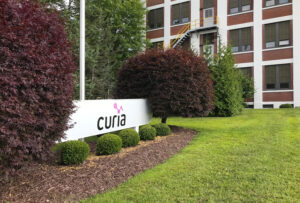Life Sciences
Chemists and biologists must work together to bring RNA-based therapeutics to market 29th March 2022

 Grant Carr, VP, Head of Global R&D Drug Discoveryat Curia, and Jamie Grabowski, VP, Portfolio and Sourcing, at Curia formerly AMRI, discuss how CDMOs with collaborating teams of chemists and biologists are facilitating the development and manufacture of lipids, lipid nanoparticles and RNA-based therapeutics for their biopharmaceutical partners.
Grant Carr, VP, Head of Global R&D Drug Discoveryat Curia, and Jamie Grabowski, VP, Portfolio and Sourcing, at Curia formerly AMRI, discuss how CDMOs with collaborating teams of chemists and biologists are facilitating the development and manufacture of lipids, lipid nanoparticles and RNA-based therapeutics for their biopharmaceutical partners.
In addition to life-saving mRNA vaccines, RNA-based therapeutics are providing treatments—and even cures—for some previously difficult-to-treat diseases, including autoimmune disorders, high cholesterol and cancer. Other types of RNA drugs include small-interfering RNA, such as Onpattro, the first FDA-approved RNA drug, which is used to treat a rare hereditary disease (1); antisense RNA, which binds to mRNA in the cell and blocks translation; aptamers, which are single-stranded oligonucleotides that interfere with protein function; and single guide RNA, which is used with CRISPR-Cas9 systems.
Having RNA-based platforms is only useful if there is a safe and effective way to get them into a patient’s body, and advances over the past decade have greatly improved drug delivery systems. It has become clear that the development, scale-up and commercial manufacture of this new class of drug products works best when the efforts of chemists and biologists are combined.
Notably, chemists have designed and synthesized multiple lipids and formulated them as a delivery vehicle, the lipid nanoparticle (LNP) that protects the RNA and enhances the solubility, absorption and bioavailability of drug products. On the other hand, the expertise of biologists is needed to design and make RNA, handle cell cultures, and purify and analyze these complex biologics. Until now, biologists and chemists have largely worked independently—often at different organizations—to create biologics (with molecular weights of as many as a few million daltons) or small molecules (with molecular weights of a few hundred daltons). RNA drugs have brought these scientists together to collaborate on such steps as the identification of early-stage drug candidates, hit-to-lead optimization and the scale up to commercial manufacturing.
The range of chemical and biological expertise needed to develop and commercialize these complex medicines is best handled by a combined service platform for the discovery and manufacture of RNA, the large-scale production of lipids, and the formulation of LNPs as the final drug product. Unfortunately, these teams of experts are often at different organizations, and both start-ups and pharmaceutical organizations have needed to engage multiple external vendors to get their drug products to market.
Bringing these services together under one roof would go a long way toward expediting the process and making it more cost-effective. In the case of lipid-based and RNA drugs, this includes finding a single partner for custom gene synthesis, design and production of modified nucleosides, in vitro RNA transcription, the production of custom lipids up to the metric ton scale, the formulation of LNPs and fill/finish of drug product.

The discovery, production and purification of custom lipids
Prior to the recent scale-up of mRNA vaccine production, only small amounts of lipids were needed by pharmaceutical manufacturers, who used them to transfect cells or stabilize large molecules for injection. With the development of RNA-based therapies, however, there is a need for specialized lipids—and more complex combinations of lipids used in LNPs—to protect the RNA, allow its delivery, and improve the ability of drugs to target specific tissues and organs.
Startups began by making gram quantities of novel lipids to test various formulations. However, successfully commercialized LNP products can require up to metric tons of custom and off-the-shelf lipids, of which there are four types: an ionizable lipid, which binds to mRNA; a PEGylated lipid, which affects the stability of the LNP; cholesterol and a phospholipid, which help form the structure of the LNP.
The development of these lipids requires expertise in medicinal chemistry, analysis of a range of lipid candidates for desirable biological activity, large-scale production, streamlined purification and formulation of RNA-LNP drug products. Commercial development of specialized lipids benefits from the coordination between a number of facilities—often geographically separated—and in-house validation and regulatory support will speed up the process.
Ionizable lipids are waxy and amphoteric, making them refractory to conventional purification techniques and dependent on chromatographic separation. Optimization of the synthetic process by chemists is essential to minimize impurities that interfere with chromatography and limit the amount of chromatography required. Streamlining the purification of lipids in this way eases the transition from clinical-scale manufacturing to the industrial-scale manufacturing of metric tons.
Formulation of lipid nanoparticles
The simplest drug substances to formulate are liquids that are miscible in water and permit sterile filtration. Filtration of a lipid solution is more challenging than an aqueous solution, requiring processing to an ideal size vesicle, generally around 100 nanometers in diameter. With RNA-LNP formulation, the compounds require mixing with specific energy to achieve this target vesicle size. This mixing process is complicated by the need to avoid deleterious effects on sensitive biologics.
For these reasons, there needs to be considerable upstream platform screening of various lipids with individual RNA components to define the perfect combination. Different techniques are used to test the two constituent solutions—the organic phase and the aqueous phase—which will direct the particle size. This includes either an extrusion process or high-pressure marginalization process to reduce the vesicle size prior to filtration.
Future innovation for lipids and LNPs
The market is ripe for more diverse lipids and LNPs, with unique properties that improve the delivery, absorption and bioavailability of biologics as well as small molecules. The functional complexity of these lipids has made them more than simple excipients. In fact, as they take on greater importance in advanced formulations, companies—and, possibly, regulators like the FDA—will treat them as complementary APIs with the necessity to manufacture them using validated processes in GMP facilities.
Some of the lipids in a typical LNP (e.g., cholesterol and phospholipids) are easy-to-order commodities. In contrast, the innovative lipids being developed are not off-the-shelf products, and manufacturers will need the support of a CDMO capable of the design, development and large-scale commercial manufacture of complex lipids, as well as the formulation of LNPs.
Simpler methods of administration for small molecules
Lipids are also used in self-emulsifying drug delivery systems (SEDDS) to allow oral delivery or facilitate absorption of the API in the gut, thus improving bioavailability and pharmacokinetics. There are currently more than 15 approved small molecule drugs formulated as SEDDS (2,3). The hope is that more complex lipids—notably the types of ionizable lipids instrumental in the LNPs used in the formulation of mRNA vaccines—can be used to package biologics in these oral formats that give patients a simpler method of administration for drugs that are currently only injectable.
Tissue-specific targeting
First-generation LNPs have served solely as a means to encapsulate the payload (e.g., RNA) and allow fusion with cell membranes to promote receptor-mediated endocytosis in a non-tissue-specific manner. Targeting specific organs or tissues is a goal but has been hampered by the tendency of any injected LNP to end up in the liver.
There is no doubt that, as the design of lipids and LNPs gets more sophisticated, chemical modifications will foster targeting of specific tissues and organs. One way of doing this would be to mimic viral uptake. The SARS-CoV-2 virus, for example, binds the ACE2 receptor on the surface of respiratory cells. Likewise, a modified lipid designed to bind to a compound found only on the cell surface of a specific tissue might facilitate targeted delivery of an LNP.
Improved stability and storage of LNPs
The effectiveness of biologics depends on their stability when stored and transported. Many rely on cold, or ultra-cold, storage and this can hamper widespread delivery. Alternative storage methods are desirable to ensure effectiveness and a robust global supply chain.
One such alternative is lyophilization and there is promising preliminary research on the stability of freeze-dried LNPs (4). Lyophilization has been used effectively for live, attenuated virus vaccines and may be beneficial in avoiding the current cold storage requirements for mRNA-LNPs (5,6).
What to look for in a contract partner
Biopharmaceutical manufacturers are looking for a proven CDMO partner to help them develop custom lipids and LNP formulations for their RNA-based and other lipid-containing drug products. Such a CDMO should have integrated teams of chemists and biologists; experience developing chemical processes for small molecules, biologics and RNA-based therapeutics; a global network of analytical labs and manufacturing facilities; and capacity to make lipids at scales from grams to metric tons.
The future of lipid-based medicines is upon us and offers great opportunities for new treatments. Together, chemists and biologists will work together to bring these innovative therapeutics to market.
References
- FDA. FDA approves first-of-its kind targeted RNA-based therapy to treat a rare disease. 10 August 2018.
- Pehlivanov I. Self-emulsifying drug delivery systems as an approach to improve therapeutic effectiveness of orally administered drugs. JIMAB 2019;25(2):2575–2582. https://doi.org/10.5272/jimab.2019252.2575
- Kovvasu SP, Kunamaneni P, Joshi R, et al. Self-emulsifying Drug Delivery Systems and their Marketed Products: A Review. Asian J Pharmaceutics 2019;13(2):73–84.
- Ball RL, Bajaj P, Whitehead KA. Achieving long-term stability of lipid nanoparticles: examining the effect of pH, temperature, and lyophilization. Int J Nanomed2017;12:305–315
- Hansen LJJ, Daoussi R, Vervaet C, et al. Freeze-drying of live virus vaccines: a review. Vaccine 2015;33(42):5507–5519.
- Uddin MN, Roni MA. Challenges of Storage and Stability of mRNA-Based COVID-19 Vaccines. Vaccines (Basel). 2021;9(9):1033.
Further Information
Email: corporatecommunications@curiaglobal.com
Web: www.curiaglobal.com


